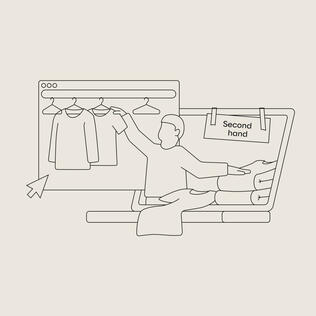We are continuing to shift deliveries to electric vehicles. Our parcel carriers will increasingly travel by environmentally friendlier delivery bikes and electric vans, especially in urban areas.
Climate footprint of e-commerce: Better than its reputation

There are many preconceived notions when it comes to e-commerce, including that it is harmful to the environment, has high carbon emissions, and uses a lot of energy. Various studies, however, have shown that the climate footprint of online retail is better than that of brick-and-mortar stores.
The Otto Group commissioned the German Clean Tech Institute (DCTI) with a study on e-commerce’s environmental impact in 2015. Many people were shocked by its findings (only available in German). The carbon footprint was better than expected, and the carbon emissions in most of the model experiments were even lower than compared to brick-and-mortar retail. An analysis carried out by experts at the University of St. Gallen confirmed this conclusion, and other studies conducted by the German Federal Environment Agency (December 2020) or the e-commerce platform Gambio (November 2021) yielded similar results: “Online” retail has advantages over “offline” retail in terms of the environmental footprint. The areas where environmental pollution is very prevalent are different, however, for the two forms of retail, and this gives us guidance on where we can further reduce or completely avoid this pollution.
Transport
Apart from emissions released in the production of goods, emissions are primarily generated during the transport of goods. TVs, shoes, or T-shirts make several stops along the way from the warehouse to the customer’s home.


According to the study by the German Federal Environment Agency (only available in German), carbon emissions from online retail are higher on the journey from the central warehouse to the parcel center than on the comparable route of the goods from the warehouse to the store. Significant differences, however, can arise during the “last mile”—the final leg of the journey to the customer’s home. If customers drive into town to go shopping, emissions increase once again depending on the route taken, while remaining comparatively low for e-commerce since parcel deliverers can fit many packages into their vans. This is much more efficient than making individual trips by car. Should the customers walk to the store or ride their bicycle instead, then there are no additional emissions caused by transport—and that’s an advantage for brick-and-mortar retail. On the whole, however, all studies come to the same conclusion: efficient last mile delivery means that e-commerce’s carbon emissions are lower than those emitted by brick-and-mortar retail, even when returns are factored in as well.
Measures pursued by the Otto Group
In order to minimize transport-related emissions and avoid them entirely by 2030, we are pursuing a variety of measures.
We are preventing parcel deliverers from having to make multiple trips by expanding the Hermes network of parcel shops and setting up parcel stations where customers can pick up their deliveries themselves 24/7. And we’re also reducing the use of options such as delivery to neighbors or having a parcel delivered to a specific destination at an arranged time.
Furthermore, intelligent route planning is helping to reduce the hazardous substances emitted during the delivery of goods to consumers. A software program helps deliverers to find the fastest routes while they are doing their delivery rounds and issues a timely alert about traffic jams and heavy congestion. 12 to 16 tons of transport-related CO₂e emissions per day have already been saved thanks to this tool.
We have adopted several measures to reduce the number of returns.
Energy and Heating
Warehouses and stores need electricity and must be air-conditioned. IT infrastructure requires energy as well, resulting in both e-commerce and brick-and-mortar retail generating emissions. However, the energy balance of offline retailers is much worse than that of online retailers, as the former need to light and heat their sales areas or cool them in summer, which is not the case with e-commerce. The figures from the German Federal Environmental Agency are clear:

The authors of the Gambio study point out that these figures do not include the electricity consumed by IT infrastructure, which is higher in e-commerce than in brick-and-mortar retail but is of little significance when comparing the overall energy consumption of buildings. Yet the fact remains that the poorer energy balance of brick-and-mortar retail in this area significantly increases the ecological footprint. E-commerce has advantages in the following areas:

Packaging
The amount of packaging waste reduces the environmental footprint of e-commerce, even though brick-and-mortar retail also generates packaging during delivery and storage. The more customers order online, the more goods have to be packaged in boxes and bags. Most of the packaging ends up in the recycling bin and can be recycled. Nevertheless, their production consumes resources, and we have not yet managed to completely dispense with plastic. Waste avoidance is therefore an extremely important goal.
Measures Pursued by the Otto Group
We have reduced the overall thickness of our cardboard to a minimum.
We use digital calculations to better match the package sizes with the products being shipped. As a result, the packages are smaller, can be stowed more efficiently during transport, and contribute to optimal vehicle utilization. The bottom line is that we can ship more goods per delivery, thereby reducing CO₂ emissions.
We avoid using filling material wherever possible. The only instance where this is not yet a possibility is for very fragile goods.
We support start-ups and projects that help reuse plastic. For example, WILDPLASTIC, which produces recyclable plastic bags from plastic waste collected worldwide. Or traceless, which has developed a biodegradable alternative to conventional plastic. Or the Spanish company Cadel Deiking, which uses an innovative process that enables high-quality recycling of plastic bags.
Summary
The studies to date based of all of these factors – transport-related emissions, energy for infrastructure, returns, and packaging – have come to a similar conclusion: The environmental balance of e-commerce is better than that of brick-and-mortar retail. While the total CO₂ emissions for transport in brick-and-mortar retail go down if customers go shopping on foot or by bike, the energy requirements of the stores themselves remain. One thing is clear: There is still a lot of potential to improve the carbon footprint of both online and offline retail. We must continue to reduce emissions and electricity requirements. We are working on it!





